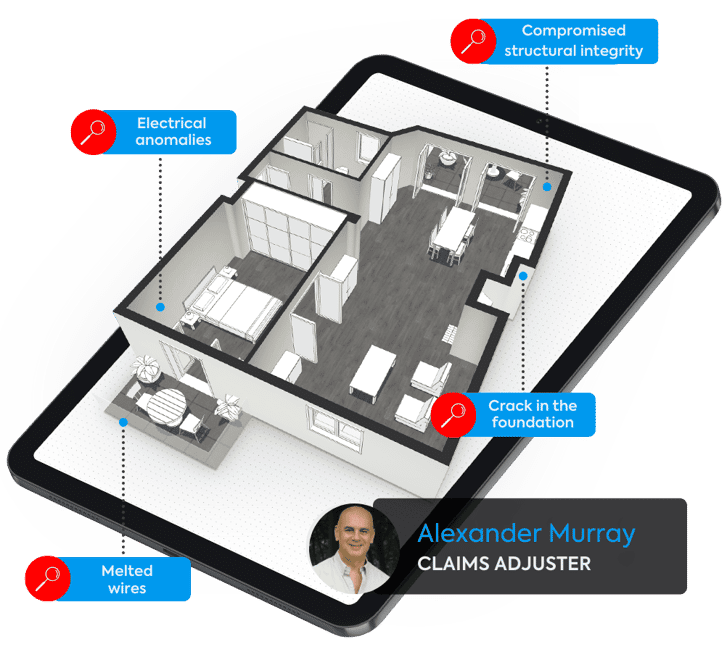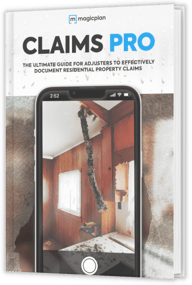Claims Adjuster
Evaluating Lightning Damage Claims: A Helpful How-To Guide for Adjusters
 Lightning strikes can cause significant and varied damages to homes. So, it’s crucial to conduct a thorough evaluation of any lightning strike insurance claim to determine the extent of losses. This guide will equip you with the basic knowledge needed to make accurate and fair evaluations.
Lightning strikes can cause significant and varied damages to homes. So, it’s crucial to conduct a thorough evaluation of any lightning strike insurance claim to determine the extent of losses. This guide will equip you with the basic knowledge needed to make accurate and fair evaluations.
First, Let’s Review the Types of Lightning Damage That Can Occur
Lightning is a powerful force of nature that can wreak havoc on homes, causing various types of damage that range from subtle to catastrophic.
One common form of lightning damage is structural impairment.
When lightning strikes a residence directly, it can fracture the roof and walls severely, leading to compromised structural integrity. Also, the intense heat generated during a lightning strike can cause roofing materials to ignite, resulting in fires that can quickly engulf the entire house.
Lightning also can weaken a home's foundation and damage the surrounding landscape. The immense energy released during a strike can create shock waves that may crack the foundation and destabilize the soil around the house. Additionally, trees and other outdoor structures near the home are vulnerable to being struck by lightning, leading to potential property damage and safety hazards.
Electrical damage is another significant concern.
As lightning strikes a house, it seeks out materials that can conduct electricity, such as metal gutters, downspouts, windows, railings – and, of course, electrical lines. When lightning surges through electrical lines, it can overload and fry electrical systems, leading to blown circuits, melted wires, sparking outlets, and the destruction of appliances, computers, and other electronic devices. A lightning strike may even lead to fire in the electrical system as the lightning seeks to ground itself through the conductive wiring. In some cases, the entire electrical wiring within the home may need to be replaced due to the extent of damage caused by the surge.
Interestingly, lightning can affect home electronics through induction, as opposed to a direct hit. This means the electromagnetic fields generated by lightning can induce currents in nearby electrical lines, ruining or degrading sensitive electronic equipment such as computers, TVs, and sound systems.
Plumbing can also be problematic.
Lightning carries a significant amount of energy, and when it strikes a home, it can create pressure waves that lead to bursting pipes and water leakage. This not only results in property damage, but also poses a risk of flooding the interior of the house, causing extensive water damage.
Now that we’ve covered the major types of lightning damage, let’s walk through five key steps of a professional claim evaluation.
1. Gather Necessary Information
Obtain and Review the Policyholder’s Claim Form
This should provide essential information, including the date and time of the incident, the location of the property, and a description of the claimed damage.
Research Historical Weather Information
Look for relevant weather storm reports and lightning strike data for the claimant’s specific area. (Weather Underground and Vaisala are two reputable online sources.) This information will be invaluable in assessing the likelihood of a lightning strike causing the reported damages.
Interview the Policyholder to Collect a Detailed Account
Find out if the policyholder or any other occupants:
- saw or heard a lightning strike, or found signs of lightning strike damage
- experienced a shock while using running water
- witnessed fire or smoke occurring
- smelled odors of burning plastic, possibly indicating damage to the coating on electrical wires
- experienced any problems within their home during or after the suspected lightning strike (e.g., lights flickering, electronics malfunctioning, appliances not working, or a complete power loss)
Interview Neighbors
Their testimony may help corroborate the reported incident.
Request Police or Fire Department Reports
If police or fire officials have already inspected the scene, request copies of any official reports that have been filed. These can be beneficial, especially if the purported lightning strike led to fire damage.
2. Prepare to Document Apparent Damage
Collect these appropriate tools for scoping and reporting on potential losses:
- A mobile device equipped with a high-quality camera
- A Bluetooth laser distance meter for precise measurements
- A mobile floor plan app, such as magicplan, that allows you to:
- sync with your Bluetooth device
- measure and sketch the property quickly for documenting purposes
- note your observations on your sketch
- create and send a lightning damage report for insurance purposes (a document containing your sketch, notes and photos)
- store and access documents with cloud technology
3. Assess and Document Structural Losses
Start with the Exterior
Being mindful of any safety hazards, begin by inspecting the property’s exterior to identify potential points of entry for the lightning strike. Start with the roof (the most common point of entry). Inspect the roof surface and chimney thoroughly. Take note of obvious holes or cracks, as well as dark, charred or otherwise damaged shingles that indicate lightning strike roof damage. Then look for visual indicators of lightning effects around the sides of the home, such as scorch marks, holes, cracked masonry, displaced bricks and shattered windows. Take photographs to support your evaluation.
/blog-fire-photo.webp?quality=low&width=727&height=419&name=blog-fire-photo.webp)
Move to the Interior
Inside the property, assess the structural integrity of walls, ceilings, and floors. Pay close attention to areas near points of lightning entry, as those are more likely to show damages. Look for telltale signs inside the home, such as insulation burn marks or moisture intrusion that might have occurred due to the lightning strike. And be sure to document all of your findings with your floor plan app and camera.
Call in an Expert
If deemed necessary, engage a qualified structural engineer to assess the extent of damage caused by the lightning strike. This in-depth evaluation will provide valuable insights into the structural integrity of the property.
4. Assess and Document Electrical Losses
Begin your electrical assessment by looking for smoke marks around the electrical panel, which can indicate damaged breakers and wiring. Then examine the electrical panel for signs of surge damage. Burnt or melted circuit breakers and damaged or fused wiring are common indicators of a lightning-induced electrical surge.
If deemed safe to do so, check the functionality of the home’s circuit breakers. Manipulating the switches can help determine whether the entire electrical system has been fried or if it's confined to only a few areas. Then move around the home to inspect internal circuitry for burnt components or other signs of damage (such as soot-like deposits on outlets), and assess whether the damage is reparable or requires replacement. In cases where surge protection devices are present, verify their effectiveness. These devices are designed to mitigate the impact of power surges, and their proper functioning can affect the coverage and extent of the claim.
Also check for lightning strike damage to electrical equipment, including electronic devices, appliances and air-conditioning. Often, lightning strikes can cause power surges that render these inoperable.
Once again, be sure to document all of your findings with your floor plan app and camera.
And remember: While assessing electrical losses, definitely prioritize safety and consult with an electrical expert when necessary. A professional electrician or electrical engineer will be able to check for hidden damage, gauge the overall operation and safety of the home’s electrical system, and provide an official damage report.
5. Assess and Document Plumbing Losses
If lightning did occur, it may have also caused damage to the home’s plumbing system, causing minor leaks or even leading to significant water damage. Even if lightning struck nearby and not directly on the home, the shock may have traveled through underground water pipes into the home. So, be sure to visually check for leaks by inspecting all pipes, connections and valves, plus any appliances that require plumbing to function.
If necessary, have a professional plumber inspect and assess the home’s plumbing system – and perhaps perform a pressure test – to identify or rule out any lightning-related damage.
6. Export a Floor Plan Sketch Directly to Xactimate®
In the context of lightning strike claims, a floor plan app with integration to Xactimate® can be a valuable tool. This technology allows claims adjusters to create detailed sketches of the damaged property and instantly send them to Xactimate® with a single click. The integration streamlines the process, reducing the time traditionally spent on manual uploads or waiting for floor plans. By leveraging this technology, claims adjusters can enhance their efficiency in processing and settling claims, thereby contributing to a more systematic and responsive approach to lightning strike evaluations.
Wrap-Up
Lightning can cause wide-ranging damages to a home, including structural impairments, electrical failures and plumbing issues. That’s why evaluation of a lightning damage claim requires a diligent and systematic approach. By conducting and documenting a thorough evaluation – and also collaborating with experts in structural, electrical and plumbing assessments – you can ensure a well-informed and fair claims process.
Continue reading our guide on Understanding the Property Claim Services (PCS Index): A Guide for Adjusters in Times of Disaster
Or find out more about Best Practices for Inspecting and Reporting on Structural Issues
Related articles

Benjamin Brown
Sales Consulting Manager

